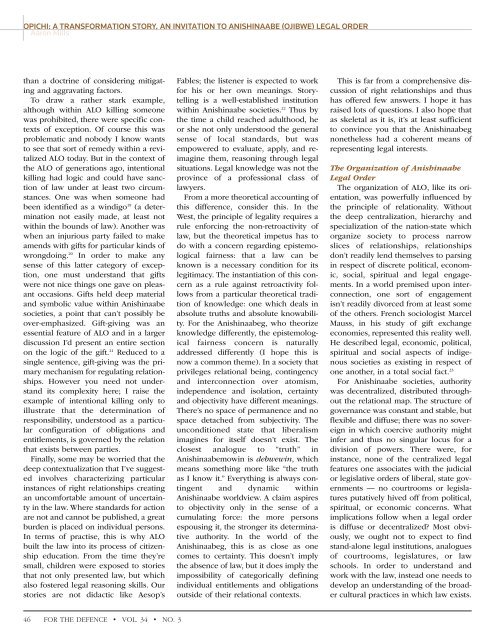FTD_Vol34_No3_web
FTD_Vol34_No3_web
FTD_Vol34_No3_web
You also want an ePaper? Increase the reach of your titles
YUMPU automatically turns print PDFs into web optimized ePapers that Google loves.
For the Defence_34-3_Layout 1 13-08-16 10:41 AM Page 46<br />
OPICHI: A TRANSFORMATION STORY, AN INVITATION TO ANISHINAABE (OJIBWE) LEGAL ORDER<br />
than a doctrine of considering mitigating<br />
and aggravating factors.<br />
To draw a rather stark example,<br />
although within ALO killing someone<br />
was prohibited, there were specific contexts<br />
of exception. Of course this was<br />
problematic and nobody I know wants<br />
to see that sort of remedy within a revitalized<br />
ALO today. But in the context of<br />
the ALO of generations ago, intentional<br />
killing had logic and could have sanction<br />
of law under at least two circumstances.<br />
One was when someone had<br />
been identified as a windigo 19 (a determination<br />
not easily made, at least not<br />
within the bounds of law). Another was<br />
when an injurious party failed to make<br />
amends with gifts for particular kinds of<br />
wrongdoing. 20 In order to make any<br />
sense of this latter category of exception,<br />
one must understand that gifts<br />
were not nice things one gave on pleasant<br />
occasions. Gifts held deep material<br />
and symbolic value within Anishinaabe<br />
societies, a point that can’t possibly be<br />
over-emphasized. Gift-giving was an<br />
essential feature of ALO and in a larger<br />
discussion I’d present an entire section<br />
on the logic of the gift. 21 Reduced to a<br />
single sentence, gift-giving was the primary<br />
mechanism for regulating relationships.<br />
However you need not understand<br />
its complexity here; I raise the<br />
example of intentional killing only to<br />
illustrate that the determination of<br />
responsibility, understood as a particular<br />
configuration of obligations and<br />
entitlements, is governed by the relation<br />
that exists between parties.<br />
Finally, some may be worried that the<br />
deep contextualization that I’ve suggested<br />
involves characterizing particular<br />
instances of right relationships creating<br />
an uncomfortable amount of uncertainty<br />
in the law. Where standards for action<br />
are not and cannot be published, a great<br />
burden is placed on individual persons.<br />
In terms of practise, this is why ALO<br />
built the law into its process of citizenship<br />
education. From the time they’re<br />
small, children were exposed to stories<br />
that not only presented law, but which<br />
also fostered legal reasoning skills. Our<br />
stories are not didactic like Aesop’s<br />
Fables; the listener is expected to work<br />
for his or her own meanings. Storytelling<br />
is a well-established institution<br />
within Anishinaabe societies. 22 Thus by<br />
the time a child reached adulthood, he<br />
or she not only understood the general<br />
sense of local standards, but was<br />
empowered to evaluate, apply, and reimagine<br />
them, reasoning through legal<br />
situations. Legal knowledge was not the<br />
province of a professional class of<br />
lawyers.<br />
From a more theoretical accounting of<br />
this difference, consider this. In the<br />
West, the principle of legality requires a<br />
rule enforcing the non-retroactivity of<br />
law, but the theoretical impetus has to<br />
do with a concern regarding epistemological<br />
fairness: that a law can be<br />
known is a necessary condition for its<br />
legitimacy. The instantiation of this concern<br />
as a rule against retroactivity follows<br />
from a particular theoretical tradition<br />
of knowledge: one which deals in<br />
absolute truths and absolute knowability.<br />
For the Anishinaabeg, who theorize<br />
knowledge differently, the epistemological<br />
fairness concern is naturally<br />
addressed differently (I hope this is<br />
now a common theme). In a society that<br />
privileges relational being, contingency<br />
and interconnection over atomism,<br />
independence and isolation, certainty<br />
and objectivity have different meanings.<br />
There’s no space of permanence and no<br />
space detached from subjectivity. The<br />
unconditioned state that liberalism<br />
imagines for itself doesn’t exist. The<br />
closest analogue to “truth” in<br />
Anishinaabemowin is debwewin, which<br />
means something more like “the truth<br />
as I know it.” Everything is always contingent<br />
and dynamic within<br />
Anishinaabe worldview. A claim aspires<br />
to objectivity only in the sense of a<br />
cumulating force: the more persons<br />
espousing it, the stronger its determinative<br />
authority. In the world of the<br />
Anishinaabeg, this is as close as one<br />
comes to certainty. This doesn’t imply<br />
the absence of law, but it does imply the<br />
impossibility of categorically defining<br />
individual entitlements and obligations<br />
outside of their relational contexts.<br />
This is far from a comprehensive discussion<br />
of right relationships and thus<br />
has offered few answers. I hope it has<br />
raised lots of questions. I also hope that<br />
as skeletal as it is, it’s at least sufficient<br />
to convince you that the Anishinaabeg<br />
nonetheless had a coherent means of<br />
representing legal interests.<br />
The Organization of Anishinaabe<br />
Legal Order<br />
The organization of ALO, like its orientation,<br />
was powerfully influenced by<br />
the principle of relationality. Without<br />
the deep centralization, hierarchy and<br />
specialization of the nation-state which<br />
organize society to process narrow<br />
slices of relationships, relationships<br />
don’t readily lend themselves to parsing<br />
in respect of discrete political, economic,<br />
social, spiritual and legal engagements.<br />
In a world premised upon interconnection,<br />
one sort of engagement<br />
isn’t readily divorced from at least some<br />
of the others. French sociologist Marcel<br />
Mauss, in his study of gift exchange<br />
economies, represented this reality well.<br />
He described legal, economic, political,<br />
spiritual and social aspects of indigenous<br />
societies as existing in respect of<br />
one another, in a total social fact. 23<br />
For Anishinaabe societies, authority<br />
was decentralized, distributed throughout<br />
the relational map. The structure of<br />
governance was constant and stable, but<br />
flexible and diffuse; there was no sovereign<br />
in which coercive authority might<br />
infer and thus no singular locus for a<br />
division of powers. There were, for<br />
instance, none of the centralized legal<br />
features one associates with the judicial<br />
or legislative orders of liberal, state governments<br />
— no courtrooms or legislatures<br />
putatively hived off from political,<br />
spiritual, or economic concerns. What<br />
implications follow when a legal order<br />
is diffuse or decentralized? Most obviously,<br />
we ought not to expect to find<br />
stand-alone legal institutions, analogues<br />
of courtrooms, legislatures, or law<br />
schools. In order to understand and<br />
work with the law, instead one needs to<br />
develop an understanding of the broader<br />
cultural practices in which law exists.<br />
46<br />
FOR THE DEFENCE • VOL. 34 • NO. 3



